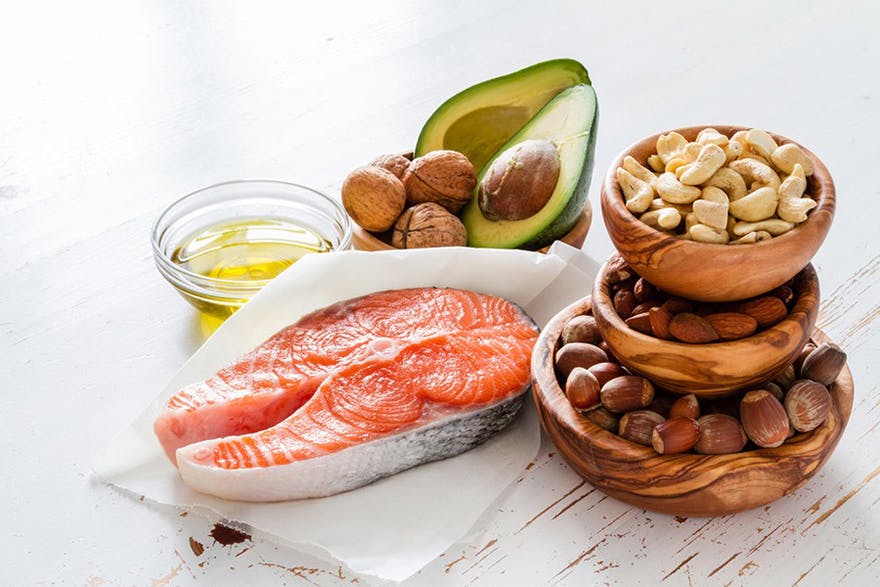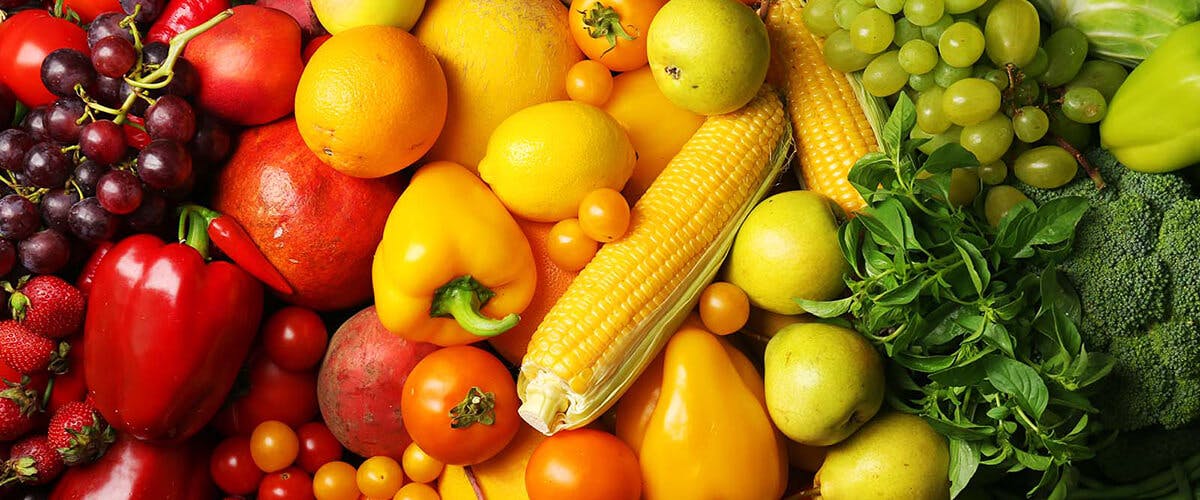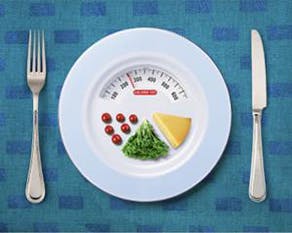The Facts About Fat
HEALTH & WELLNESS
10.21.2014

Many people finger dietary fat as the culprit for clogged arteries that cause heart attack and stroke. While the amount and type of fat you eat influences your health, all fats are not created equal. Certain kinds of fat in food actually support your heart, as well as the rest of your body. Find the right balance of heart-healthy fat in your eating plan.

Three Ways Fat Does a Body Good
There’s no reason to slash fat in the name of heart health. Consuming too much bad fat may put you at risk for heart disease, but following a very low fat eating plan could, too. Here are some reasons why you need fat.
- Food fat provides Essential Fatty Acids (EFA), compounds the body cannot make and must get from food. Slashing total fat can result in a deficiency for the types of fat that benefit your heart, brain, and eyes.
- Dietary fat provides eating satisfaction, so you may eat less and have an easier time with weight control.
- Very low fat diets often feature more highly refined carbohydrates, the kind found in foods such as white bread, rice, and crackers.
Studies show eating healthy fats in place of refined carbohydrates decreases blood levels of artery-clogging low density lipoproteins (LDL) and increases protective high-density lipoproteins (HDL).
(Sources: Appel L, Sacks F, Carey V, et al. Effects of protein, monounsaturated fat, and carbohydrate intake on blood pressure and serum lipids: results of the OmniHeart randomized trial. JAMA. 2005;294:2455-64; Mensink R, Zock P, Kester A, Katan M. Effects of dietary fatty acids and carbohydrates on the ratio of serum total to HDL cholesterol and on serum lipids and apolipoproteins: a meta-analysis of 60 controlled trials. Am J Clin Nutr. 2003;77:1146-55)
Dietary Fat: The Good, the Bad, and the Ugly
In matters of the heart, some fats are better than others. Food contains a mixture of good and bad fat, but one type always prevails and tends to be associated with that food.

GOOD: Unsaturated fats
Experts suggest that most of your fat should come from mono- and polyunsaturated fats – the unsaturated fats - because eating them as part of a balanced diet helps to improve blood cholesterol levels, reduce inflammation in blood vessels that could lead to heart disease, and keeps your heart beating normally. Canola oil, olives and olive oil, safflower seed and flaxseed oils, avocados, peanut butter, almonds, pistachios, cashews, and seeds are among the foods that supply unsaturated fats.
Seafood harbors docoxahexaenoic acid (DHA) and eicosapentaenoic acid (EPA), two important unsaturated fats for heart, brain, and eye health. DHA and EPA decrease triglycerides (fat that contributes to heart disease), reduce the risk of sudden death from abnormal heart rhythms, slow the growth of plaque in arteries, and slightly reduce blood pressure. (Source: http://www.heart.org/HEARTORG/GettingHealthy/NutritionCenter/HealthyDietGoals/Fish-and-Omega-3-Fatty-Acids_UCM_303248_Article.jsp#) Health experts recommend eating at least two fish meals a week.

BAD: Saturated fat
Your body makes all the saturated fat it needs, so you don’t need any from foods, such as cheese, lard, butter, bacon, full-fat dairy, and fatty meats. There’s no need to completely avoid saturated fat for heart health, but try to limit it to 7% to 10% or less of total calories – a maximum of 22 grams a day on a 2,000-calorie eating plan.
You may have heard recent reports that heart disease and stroke risk is not related to saturated fat intake, but health experts have not yet reached a general agreement on the issue. Here’s what we do know: Eating more than the recommended amount of saturated fat may result in higher total and LDL cholesterol in your blood, which could result in clogged arteries that block the flow of blood to your heart and your brain.

THE WORST: Trans fat
You can live without trans fat. In fact, your heart will thank you for avoiding them.
Studies suggest increased trans fat intake is linked to a greater chance for cardiovascular disease, including heart disease. According to the Harvard School of Public Health, trans fats are worse for cholesterol levels than saturated fats because they raise bad LDL cholesterol and lower good HDL cholesterol. Trans fat also cause inflammation, an overactive immune system response that may be to blame in part for heart disease and stroke. Even low levels of dietary trans fat can have harmful health effects.
While fatty meats and full-fat cheese supply very small amounts of naturally-occurring trans fat, processed foods supply far more. Foods such as stick margarine, microwave popcorn, pie crust, donuts, packaged frosting, and biscuit dough, are by far the biggest sources of trans fats. The best way to avoid trans fat is to curb consumption of processed and restaurant foods.
The American Heart Association recommends limiting trans fat intake to less than 1% of total calories, which is about 2 grams or less on a 2,000-calorie diet. Avoiding trans fat will be a lot easier if the Food and Drug Administration’s proposed ban on artificial trans fat in the food supply becomes a reality. Under the proposed regulation, partially hydrogenated oils, a type of trans fat, could no longer be added to foods.
Focus on Good Fat
You know which types of fat are good for you, but how much can you have?
Suggested fat intake is based on calorie needs. For example, the American Heart Association recommends an eating plan with 25% to 35% of calories coming from total fat, which amounts to 56 to 78 grams of total fat daily, or less. That may sound like a lot of fat, especially to people who have become accustomed to the notion that eating fat makes you fat. But total calorie intake is what matters most for weight control. Eating excess calories from any source, including protein and carbohydrate, may add unwanted pounds.
Knowing your total, saturated and trans fat limits is helpful for reading food labels, but trying to remember all those numbers may be too much to think about. No worries.
4 Strategies for Heart-Healthy Eating
These strategies make heart-healthy eating a snap.
- Replace butter with oil: Use oils to cook and season your food instead of butter and lard, but don’t overdo it on olive, canola, and other healthy oils. Each tablespoon of oil has about 120 calories and 13 grams of fat.
- Eat fish: Aim for two fish meals (8 ounces total) weekly.
- Limit saturated fat: Curb saturated fat intake by limiting red meat and swapping full-fat dairy foods for low-fat or fat free versions. Eat smaller amounts of cheese (don’t forget to count pizza).
- Substitute lean protein: Include more beans, nuts, and poultry in your eating plan to reduce reliance on meat and cheese for protein.
Image credits: Oleksandra Naumenko/Shutterstock.com
Recommended Articles
The 5 Best Foods That Will Help Supercharge Your Brain
Amidst our busy schedule, it's important to retain our focus and memory. Resting alone is not...
Iron deficiency is a lot more common than you would think. A recent survey by SATA CommHealth(i...
Mars vs Venus: Understanding the His and Hers of Nutritional Needs
Mars vs Venus: Understanding the His and Hers of Nutritional Gaps Although their DNAs are...






